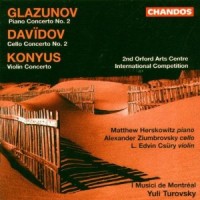Konyus, Davidov, Glazunov
|
Louis Klonsky [November 1998. Originally appeared in La Folia 1:4.] KONYUS Violin Concerto ; DAVIDOV Cello Concerto No. 2 ; GLAZUNOV Piano Concerto No. 2. L. Edvin Csury (violin), Alexander Ziumbrovsky (cello), Matthew Herskowitz (piano); I Musici de Montreal, Yuli Turovsky (cond.). CHANDOS CHAN 9622 (69:32). During a recent vacation in Toronto, I was passing time at Tower Records as my spousal unit and daughters were on a relentless quest to wear out the magnetic strip on the Visa card at the local garment emporia. (“But Louis, you know winters in California are brutal. Our kids need clothes and the US dollar goes so far here.”) While mentally calculating if I was suffering greater fiscal damage from the shopping extravaganza or the recent S&P 500 slide, I came across this new release, proudly displaying the Canadian Maple Leaf on its cover. Temporarily overwhelmed by the thought of hearing some unknown repertoire and new artists, I halted my computations, and decided that helping my hosts in their balance of trade dilemma was more important than personal fiduciary responsibility. Hence I added the disc to my collection. Besides, I heard the US dollar goes further in Canada. The recording is part of the prize for winning the Second Orford Arts Centre Competition, initiated by Yuli Turovsky, Artistic Director of Orford’s International Festival, founder of I Musici de Montreal Chamber Orchestra and conductor of these performances. (For those wanting more information on the festival and school, I suggest a visit to www3.sympatico.ca/arts.orford/. For additional data about I Musici and Maestro Turovsky, a visit to www.jwentworth.com/musici/index.htm is a worthwhile excursion.) Production standards are of Chandos’ typical high level. The balance marginally favors the soloists, but given the nature of the recording, this is a plus. Generally, the sound from the augmented I Musici is clear and warm, but occasionally, during the fortes, a bit muddied. This is probably due to the reverberance of the recording venue, L’eglise de la Nativite de la Sainte-Vierge. Excellent notes by David Fanning contain useful biographical information and descriptions of the works. Additional anonymous notes describe the careers of the performers. Yuly Konyus, the 19th-20th century composer/violinist/pedagogue, composed the one- movement Violin Concerto, in 1896. It has been popular with several well known violin virtuosos, including Heifetz, whose recording is currently available. As annotator Fanning indicates, it is chronologically and stylistically between the Tchaikovsky and Sibelius Concertos, if not on their musical level. The movement, marked Allegro molto, has quite a few changes in tempo. It is by default predominantly lyrical in nature, since its attempts at dramatic contrast are no more adrenaline inducing than those occurring when you suddenly realize that you forgot to wash your car. Although the violin tone produced by the soloist, L. Edvin Csury is a bit too dry for my taste, he plays with a clear articulation and is more than up to the piece’s considerable technical challenges. The once popular late-19th-century composer Karl Yul’yevich Davidov originally studied mathematics, but soon after college switched to cello and composition. Aside from achieving a degree of success in both these professions, he also proved an effective administrator, as a respected director of the St Petersburg Conservatoire. Among his compositional achievements are four cello concertos. While breaking no new ground, the work on this recording is worthy of more than a casual listen. a beautiful Andante follows the soulful initial Allegro. Fanning suggests that the opening of the Andante, which consists predominantly of an interplay between woodwinds and cello, may have served as the model for the Adagio of Dvorak’s Cello Concerto. I agree, and also think it possible that Dvorak could have jotted down a few ideas from the first movement too. The Andante, as singingly played by Alexander Ziumbrovsky and I Musici, is a highlight of the disc. It’s too bad that the Allegro con brio, despite its faithfully executed virtuosic requirements, is not on a level with the work’s previous sections. The show-stopper, Glazunov’s Piano Concerto No. 2, is a four-movement composition, played without pause. Composed in 1917, it may as well have been written decades before. But so what if it is filled with gobs of lyrical and bravura passages and a “heroic” finale that make it at least a typical, if not archetypal, Russian piano concerto. Matthew Herskowitz has a big sound, and like the other winners, is in total technical command of the material. Also, as with the other concertos, Maestro Turovsky and his augmented I Musici provide a firm accompaniment. (If the reader cares to learn a bit about Glazunov as musician and mensch, I suggest reading, or rereading, the appropriate sections from the Shostakovich/Volkov book, Testimony. Here’s a teaser: “I appreciate Glazunov’s greatness, but how can I make others understand it?”) Unhappily, both soloists play with little flexibility or spontaneity. Given the circumstances of the recording, a somewhat “academic” rendition is not surprising, but some judiciously applied schmaltz might have heightened the impact of these “lesser” concertos. Nevertheless, while not filling any missing gaps in the catalog, this disc provides a quality choice to the few options available. Anyone interested in this repertory won’t regret adding it to their collection – whether paid for in dollars or Loonies.
[More Louis Klonsky, Vol. 1, No. 4]
[Previous Article:
Five from hatART]
[Next Article:
Schubert Lieder on CD]
|
